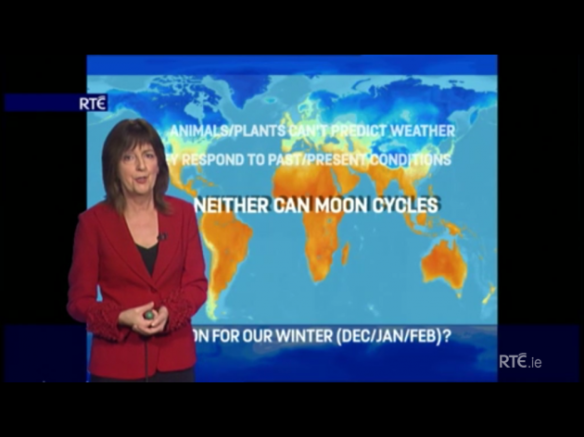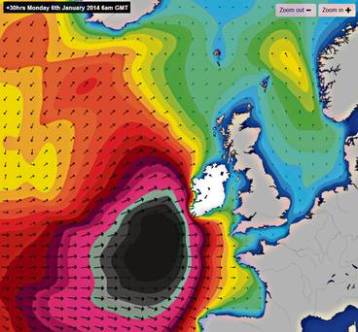Happy New Year! With the old year now over, we can look back at Ken Ring’s final predictions for the winter, his “overall” predictions for the year, and how he did in total.
So the last few predictions – sorry, he’s calling them “suggestions of potential” now – for #kenringwatch 2014, were as follows:
Nov
25. Mild temperatures up to November (1)
26. 19th November, subzeros back (1)
Dec
27. 4th to 9th, first snow of winter (1)
28. No white Christmas, but subzero on the 24th, 25th (1)
How did Mr Ring do?
25. Yes, absolutely, this autumn and winter have been mild. In fact, Met Éireann tells us “Many stations recorded their highest maximum temperatures for winter in 6 to 15 years. Lowest minimum temperatures were the highest for winter on record at many
stations, Shannon Airport reported its highest minimum for winter in 68 years” (2) I might put that down to climate change – Ken would disagree, as would, according to him, most Irish farmers, who are immortal, or something, and know all of this is just cycles…
Regardless of the reasoning, though, that’s definitely a point for Ken.
26. Ah, I love these black or white predictions. The Met Éireann report for November tells us that November was “Typical for the time of year, milder at the start of the month.” That report tells us that the 19th was a perfectly average day for the month – minimum temperatures between 5 and 10 degrees Centigrade, max between 10 and 15. Certainly not subzero.
November: One for two.
27. The monthly report for December hasn’t been published yet on Met Éireann, which means checking various weather stations for particular dates. Let’s pick Cork, Dublin, and Shannon Airports, and Malin Head. Checking them each day from the 4th to the 9th, we find:
Cork: Too warm for snow and/or little to no precipitation;
Dublin: Same;
Shannon: Same;
Malin Head: Yes, same.
No snow. No points.
We then got a cold snap and severe winter storm, which Ken didn’t mention. That brought snow – but it didn’t arrive until the 11th, didn’t last long, and only hit a few counties.
28. Ken was correct about no white Christmas, but the lowest temperature recorded over both days at the aforementioned weather stations was 0.8 degrees Centigrade. Predicting no white Christmas is a banker (it very rarely is), but them’s the breaks. Half a point.
December: 0.5 for two.
Ken also made two “general” predictions that we couldn’t measure until the year was over:
1. The coming winter (2013/14) won’t be severe (3)
2. No hotter than 25 or 26 degrees at any point in the year (1)
1. Looking back to the Winter 2013/2014 report for this one. The report headline tells us: “Stormy at times; wettest winter on record”. Under the various headings, it goes into more detail: “Over 50% of stations across the country reported it was the wettest winter on record. Valentia Observatory reported its wettest winter since records began in 1866 (148 years) with 848.0mm and 183% of LTA, while Malin Head reported 530.7mm, 164% of LTA its wettest winter since records began in 1885 (129 years). Shannon Airport had its wettest winter on record (68 years) while Mullingar reported its wettest winter on record (63 years).” Similarly, for wind speed, we’re told: “Winds were above average for winter with storm force winds on occasions. Dublin Airport’s winter mean windspeed value of 14.4 knots (26 km/h) was its highest since 1943 (71 years), Shannon Airport reported its highest winter mean windspeed in 31 years” and “The highest gust of the season was 86 knots (159 km/h) at Shannon Airport on the 12th February, its highest for winter on record (68 years).” , and “A new record maximum wave of 25 metres was reported at the Kinsale Energy Gas Platform on February 12th.”
These records were due to the series of severe storms that arrived in January and February, and about which Ken said nothing. But a picture paints a thousand words:

Lahinch promenade during one of January’s storms. Photo by George Karbus, http://www.emerald-vision.com/
Zero points.
2. Most annual highest maxima were recorded during July. The year’s highest temperature
was 31.0°C recorded at Dooks, Co Kerry on Saturday, July 19th, the stations second
highest maximum since it opened in 1997. Five degrees higher than predicted – so, zero points.
“Overall” category: Zero for two.
Total for the year: Seven for twenty-eight. 25% accuracy, exactly.
Ken Ring claims 80% to 85% accuracy, but it turns out that when you record his predictions, and check back, then being generous, he’s right one time in four, on average. Half as accurate as a coin-toss.
Conclusions:
1) Moon and tides are of no use whatsoever in predicting the weather.
2) Spending €50 plus postage and packing for an almanac that’s right (presumably) one time in four would not appear to be a good investment.
“It’s just a bit of harmless fun” is sometimes repeated by reputable journalists as a reason for allowing Ken Ring to use their publication or programme to publicise his almanac. Well, he can’t be done under the Trade Descriptions Act (or else Old Moore’s Almanac would be out of business) – but he is selling his pseudoscience “predictions” at €50 a shot and claims to be selling 1,000 a year. Which would be great if it was accurate, but not when the accuracy is only half as good as a coin-toss. In my opinion, file under crank, snake-oil, or charlatan. If you must invite him on to your show to fill a slow news day, then also invite on a pseudoscience skeptic, or a spokesman from Met Éireann. I suggest Evelyn Cusack.
Sources:
(2) http://www.met.ie/climate/MonthlyWeather/clim-2014-win.pdf
(3) http://www.radiokerry.ie/news/new-zealand-weather-forecaster-predicts-a-typical-irish-winter/


